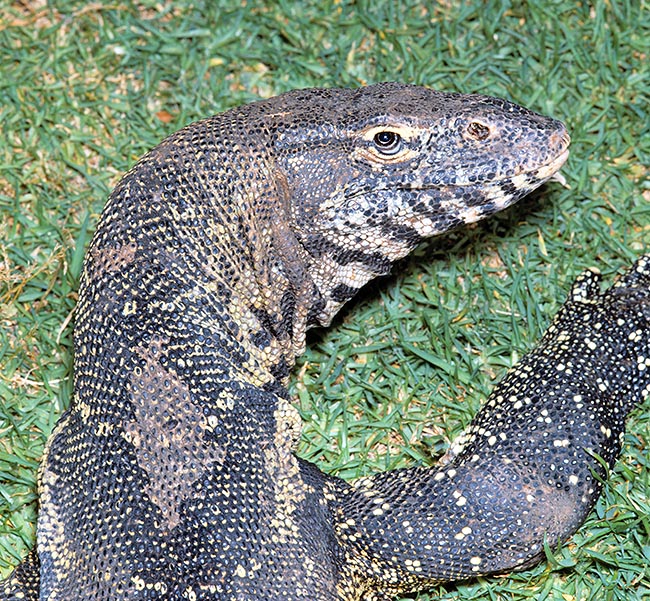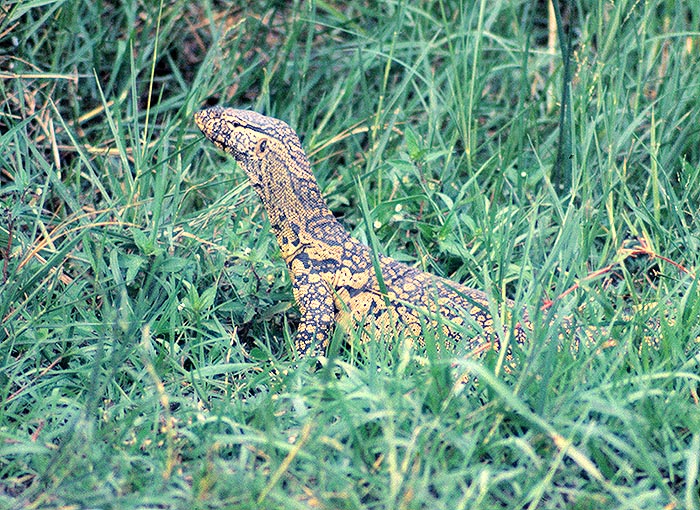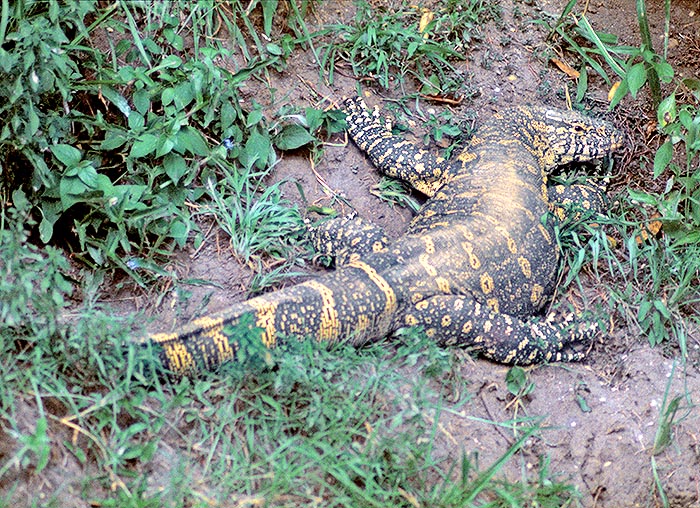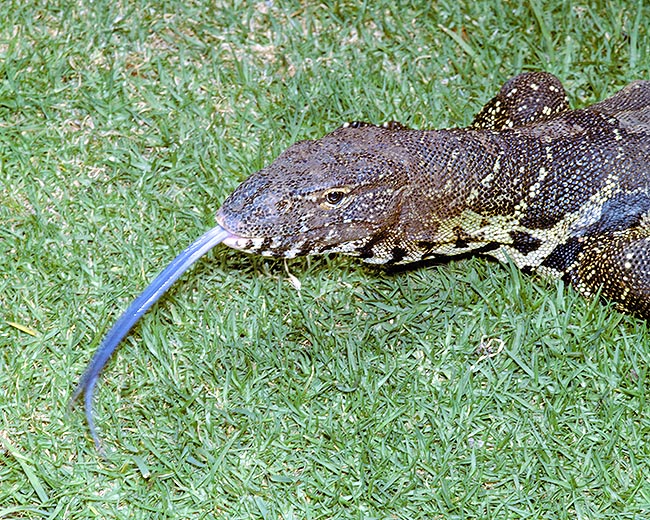Family : Varanidae

Text © Bryan Waterloo
Class: Reptilia – Order: Squamata – Family: Varanidae – Genus: Varanus – Sub Genus: Polydaedalus – Species: Varanus niloticus Linnaeus, 1766. Common name: Nile monitor.
Geographic Range
Varanus niloticus Linnaeus, 1766 occurs over most of Africa; only 5 countries are not part of their range – Algeria, Libya, Morocco, Tunisia, and Western Sahara. Varanus niloticus is absent from the island of Madagascar. The northernmost location is believed Aswan, Egypt. Populations this far north are presumed to be living in close proximity to the Nile River. Varanus niloticus is not found in desert areas that extend in Botswana, South Africa, and Namibia. In Somalia and Kenya they are not found along the coastline. They will inhabit transition zones bordering these desert areas. Populations occurring in the rain forest regions of West and Central Africa share territory with their close relative Varanus ornatus.
Physical Characteristics
Size and weight
Varanus niloticus has long been considered the largest lizard in Africa. Reports of 3 m specimens have been rumored but never confirmed. The largest documented Varanus niloticus was a reported female shot and killed near a school in Pretoria, South Africa in 1994. This large female measured in at ¾ of an inch shy of 2,4 m. I could not find any recorded weight, however estimates ranged from 12-15 kg. The largest monitor lizard in Africa is Varanus ornatus a dweller of the rainforest regions of West and Central Africa. Long considered a subspecies of Varanus niloticus, it has been recently elevated to full species status. The largest documented Varanus ornatus measured 2,5 m, hence making Varanus niloticus the 2nd largest lizard in Africa. Varanus niloticus adults average 2 m. Specimens from some of the eastern and southern ranges obtain larger sizes, in particular specimens from Uganda have been the largest I have seen. The average weight ranges from 5-10 kg, with exceptions another large female captured in South Africa measured 2 m and weighed in at 17,3 kg. Hatchling Varanus niloticus range in size from 15-30 cm and weigh in range from 20-25 g.
Body structure
Tail length normally makes up about 60% of the total length. The tail of Varanus niloticus serves many purposes, most commonly for swimming. Designed similar to an oar roughly 2/3rds of the tail are laterally compressed with a very high keel. While submerged this aquatic feature makes swimming appear effortless. The base of the tail is used for a fat reserve during leaner months; this also aids females during reproduction. As a weapon large specimens can inflict well aimed strikes in a whip fashion capable of blinding pesky intrusions. Prehensile capabilities are most apparent in juveniles and hatchlings however adults still utilize this ability when climbing structure. Adults have been documented using their tail as a protective barrier when sleeping in their burrow.

Its diet is much varied. It’s a crocodiles’ prey, but it controls their number by eating the eggs © Giuseppe Mazza
Varanus niloticus is well equipped with muscular front legs designed for digging and climbing. In combination with their equally built rear legs they can cover large distances of various terrains. In addition to climbing and digging Varanus niloticus will use their front claws to eviscerate large prey items in most instances this pertains to consuming carrion.
Varanus niloticus is well equipped with powerful jaws and bone crushing teeth. The general shape of their head is triangular. Adult specimens have well developed cranial musculature. The strongest points converge at the base of the mouth, lower bottom jaws and the top of the skull just behind their eye sockets resembling to bumps. This concentrated area exerts the massive crushing power capable of cracking hard shelled prey items.
Hatchlings start life with sharp small teeth designed to catch faster moving prey such as insects. During the transition from neonate to adult blunt, molar type teeth begin to develop at the base of the jaw. These type of teeth combined with impressive crushing power enable adults to feed on hard shelled preys as crabs or crunch bones and on birds.
Visual acuity of Varanus niloticus is very well developed and comparable to the focusing action of binoculars. This ability can detect slight movement from small prey items moving around, to an approaching threat – from the same vantage point. While submerged a thin protective membrane protects their eyes much like goggles, as a result their ability to see underwater is uncompromised. Sight, aside from guiding one to food or escaping an approaching threat is used to communicate (posture). Visual clues from posture are used primarily during breeding season and territorial disputes. Eye protection comes in the form of eyelids, this is very noticeable when struggling with prey and while sleeping.
The ability of hearing sound is limited. Varanus niloticus is equipped with ears on both sides of its head at the connection point of their skull and spine. Both large openings are covered with a thin layer of skin. Folds of skin on the neck provide some protection. Loud noises are said to initiate a response. The sensory apparatus including the tongue and Jacobson’s organ of Varanus niloticus is extremely developed. Monitor lizards in motion will tongue flick continually, each retraction detects particles in the air. Once retracted into the mouth both forks of the tongue pass the Jacobson’s organ immediately processing these particles to guide them to their objective. The power of these two organs combined is amazing; in one instance carrion was detected from 11 kilometers away. This amazing trait carries over while submerged, prey items hiding are easily found and pulled from hiding places deemed safe from predators.
During the breeding season males will track ovulating females from many kilometers away to with in meters of each other. Sub adults are reported to pick up on scents from adult monitors in areas with high concentrations of prey; paths to water areas, game trails, and nesting areas. Territory boundaries of both male and female are detected by scat and rubbing their bodies amongst trees, the ground or large rocks. These undetectable clues are easily picked up thru tongue flicking and aid in unnecessary advances by either sex. Gravid females are thought to detect active termite mounds by temperature ratings once reaching suitable nesting spots inside the mound. Tongue coloration varies from bluish black, dark purple, to a reddish purple. The nostrils of Varanus niloticus are situated at the same level of the eye; this design maintains airflow and vision while swimming. The inside wall of the nostril has a flap of skin enabling the lizard to plug their nostrils keeping water out of their lungs.
Pattern and Coloration
The extensive range of this lizard results in a myriad of colors and patterns from one location to the next. A few common markings are present no matter the locality. All Varanus niloticus have a pre and post ocular band that extends to the base of their head. From the base of their tail to almost the tip is a series of bands. In some localities this can be very pronounced with many and in some a very faint pattern. The tip of the tail ends in a solid color; yellow or black are most common. Running along the jaw line is a series of inverted triangular markings. These markings extend from the tip of the snout to about even with the ocular banding. In localities such as West Africa and Uganda these markings can have an aqua blue hue to almost sky blue color. From the shoulders to the base of the tail are a series of bands. These bands can be from 6-9 rows and yellow, gold, or pale white in coloration.

Picture of Varanus niloticus from a boat along the Nile banks at Murchison Falls © Giuseppe Mazza
In some instances the pattern can be so broken up it appears as a peppered color with very faint bands. Ocelli or solid spots can be extreme or faint depending on locality. The basic dorsal color ranges from bluish black to olive green / brown. Some adults have an almost faded uniform color with few markings. Dark patterned specimens are usually found near tropical locations, lighter sandy patterns are better suited in dryer grassland locations. Limbs are usually covered with smaller spots, some can have banding instead; usually this is only present on the front limbs.
Throat patterns vary from a dirty white coloration with small ocelli to bright white with a bluish gray reticulated pattern. Nile monitors occurring in South Africa have solid banding that breaks at about the mid section of the throat, usually a dark blue color on a pale white to pale yellow coloration. This same pattern continues onto their stomach markings. Furthermore some stomach patterns are marked with faint gray markings on a white to pale yellow color. As hatchlings Varanus niloticus is adorned with brilliant mixes of gold and black combined with crisp bandings of spots and ocelli. As they mature these colors begin to fad and by young adulthood hardly reminiscent of their former selves.
Diet
Versatility best describes the diet of Varanus niloticus. Their foraging abilities cover all types of terrain, a trait that carries well into all stages of their life. Prey items consumed is quite extensive usually any species they can over power and fit into their mouth. In locations where both Varanus niloticus and Crocodylus niloticus occur, Nile monitors fill a niche of population control by feeding on eggs and hatchlings.
Nest raids usually involve more than two lizards resulting in almost every egg consumed in the matter of minutes, usually rendering the nest useless. Populations occurring in semi arid and temperate zones rely heavily on carrion for much of their diet. Once warm weather and rain returns this feeding strategy is reduced, returning back to regular prey items. Nile monitors found in urban areas will sift thru garbage heaps consuming scraps of meat. Considered a thief and pest, they will take fish from outdoor markets and raid chicken coops for eggs, and chicks. Species consumed include insects, spiders, scorpions, locust, beetles, caterpillars, amphibians, reptiles (including venomous snakes), birds, small mammals, bats, crustaceans, mollusks, and the eggs of both reptiles and birds. Nile monitors will cannibalize smaller specimens.
Ecology-Habitat
As hatchlings Nile monitors are secretive and tend to be arboreal, finding shelter and a means of hiding from predators amongst the branches. Tree dwelling insects provide nutrition without leaving the security of height.
When hunting at ground level hiding in shallow water amongst the reeds, terrestrial foliage, tall grasses, and water plants provides additional shelter. Approaching threats are handled by sitting still, a quick dive into deeper water, or a quick burst up the nearest tree. Despite these best efforts nearly 90% of hatchlings are preyed upon in the first few months of hatching. Young adults that have survived the ravages of youth are wiser to the environment and observant to perceived threats, as well their diet has increased to additionally larger prey items assuring continuous growth.
Once they reach the 1 m mark and larger fewer predators consider them prey, or want to bother with their bold nature. As an adult they overcome and adapt to harsh conditions; during droughts they scavenge, temperate weather they estivate. They adjust to human encroachment and learn to exploit all that it offers.

At Murchison Falls they may easily exceed the 2 m. If in danger, they jump into the water or climb the trees © G. Mazza
Utilizing the landscape, Nile monitors develop hunting, basking, and retreat areas over a series of different terrains within their territory. During months of intense heat cool areas are sought reducing activity levels to a minimum. Colder weather results in hours of basking throughout the day. Both of these weather conditions reflect the choice of territorial ranges sought by seasoned adults.
Sleeping areas and shelter for adults usually are burrows dug by a former meal. Decayed hollow trees provide shelter as well. In most instances shelter is located in close proximity to water. Spooked Nile monitors will jump from great heights into water trying to evade threats. Adults have been reported to die from falling asleep on tree branches high above ground plummeting to their death from losing their grip.
Nile monitors have 4 chambered hearts, there metabolic achievements rival most mammals. During boughts of active foraging they can track, excavate, and consume prey without the slightest change in heart rate. While submerged they can reduce their heart rate slow enough to submerge for 60 minutes.
During lean months in a state of aestivation there able to sustain using the slightest of energy relying on fat stored in their tail to survive.
Nile monitors can easily outrun humans; their exact speed is unknown but estimates range from 25-35 kilometers an hour in a short burst. During aquatic excursions notably while swimming, Nile monitors keep their legs tucked to the sides of their body primarily using their tail as a means of propulsion. Reminiscent of a crocodile they can cover long strides with a few short side to side bursts with their tail. The lifespan of Nile monitors is believed to range from 15-30 years. They are often considered one of the smartest of African reptiles.
Reproduction
The reproductive organs of both sexes are stored internally. In both sexes their located on both sides at the base of the tail behind the vent. Males have two hemipenes and females have two hemiclitoris. During copulation both can alternate usage when shifting sides. These organs are separate from the digestive tract unrelated to voiding waste.
Weather changes are the catalyst of reproduction for Nile monitors. Returning monsoons and warm temperatures inject a revival of life and the coming of an abundance of prey. These climatic changes signal both sexes breeding season has arrived. Territorial ranges of both sexes often overlap each others being many kilometers in size. Having the smaller of ranges females begin to release pheromones attracting mature males to their location.
Often many males will converge to the same female resulting in combat, often in range of the female. Male ritual combat is best described as a form of wrestling; both combats will circle one another ending in a bipedal clinch phase grappling with their front legs, while standing on their rear legs. The objective is to overpower, knock down, and subdue.
The losing combatant is normally chased off with a few scratches and the occasional nip on the feet or tail. The dominant male will now pursue the female to begin copulation. Approaching the female, the male will pair up to one side of her and begin to rake her tail base with one of his hind legs. If the female tries to break free the male may grip the neck area of the female with his mouth.
Once the female submits to the raking motion by the male she will lift her tail base allowing access and copulation begins. This process can last for many hours and occur over the course of a week. Once copulation is over both go their separate ways.

Thanks to Jacobson’s organ, its showy forked tongue may locate 11 km distant preys © Giuseppe Mazza
In many instances males outclass their partner by 2-4 kilograms and up 1 meter in length. Small equal sized males can be tested by large females and sometimes drove off.
All monitor lizards are oviparous; Nile monitors utilize the enormous nest of termites to lay their clutch. With their strong front legs females dig into the side of active mounds, deposit their clutch and leave with no further maternal assistance.
Females will stay around the nest for a few days, presumably to ward off other gravid females from using their mound. Eventually they wander off. Repair to the mound ensures a protective chamber safe from most predators.
The size and internal temperatures of termite mounds provide ideal incubation requirements for the growing eggs.
Ambient air temperatures inside the mound range from 27-31C, directly related to the sun ray catching effects of the mound.
While cultivating their fungi, termite activity maintains high humidity levels providing ideal conditions. Incubation can vary from 6-9 months; once hatching begins it may take up to 48 hours for the entire clutch to free of its egg. How the young escape is not known, rain is believed to soften the walls and they dig out. However digging thru the tough outer shell of the mound seems an impossible task for such a small lizard. One thought is they make their way out by finding openings near the top of the mound.
Clutch sizes range from 25-60 eggs, larger females producing the greater numbers. The leathery eggs are roughly 35 x 60 mm in diameter. This symbiotic relationship is not understood and appears to favor Nile monitors more than termites. Possible theories relate to additional food source for the termites left over from hatching (egg fluids), and egg fragments. Both would undoubtedly provide a growth of fungi in a hot and humid environment.
Survival points
The continued success of Nile monitors provides insight to their power of adapting to change. Lack of water appears to be their only shortcoming and at the very least they can survive for months without it. As one of the largest reptiles in Africa few predators consider adults prey. Utilizing desolate landscapes for basking or living in man-made alterations to the environment they survive were some species would fall out of existence.
Man is the biggest threat to Nile monitors, many hundreds of thousands a year are killed for the fashion industry becoming belts, wallets, and boots. Deforestation is another hurdle plaguing all animals forcing extinction and clashes with humans. Thankfully in many countries Nile monitors are protected and safe to live their incredible, adaptable, and amazing lives.
References
Faust, Robert. Nile monitors 2001 Barron’s Books; Bennett, Daniel. Monitor lizards 1998 Chimaira; Pianka, Eric & King, Dennis. Varanoid lizards of the world 2004 Indiana press
Studies and research
Marwell Wildlife – Colden Common – Winchester Hampshire SO21 1JH – England (UK); Giza Zoological Garden – PO Orman – P.O. Box 12612 Giza – Egypt Kyiv Zoological Park – 32 Peremohy Prospect – Kyiv 03055 – Ukraine; Silesian Zoological Garden – Promenada Gen. Jerzego Ziêtka 7 – 41-501 Chorzow Katowice – Poland.
→ To appreciate the biodiversity within the LIZARDS please click here.
